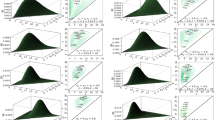Abstract
A new bivariate pseudo Pareto distribution is proposed, and its distributional characteristics are investigated. The parameters of this distribution are estimated by the moment-, the maximum likelihood- and the Bayesian method. Point estimators of the parameters are presented for different sample sizes. Asymptotic confidence intervals are constructed and the parameter modeling the dependency between two variables is checked. The performance of the different estimation methods is investigated by using the bootstrap method. A Markov Chain Monte Carlo simulation is conducted to estimate the Bayesian posterior distribution for different sample sizes. For illustrative purposes, a real set of drought data is investigated.


















Similar content being viewed by others
References
Arnold BC (1990) A flexible family of multivariate Pareto distribution. J Stat Plan Inference 24(2):249–258
Chaccko M, Thomas PY (2007) Estimation of a parameter of bivariate Pareto distribution by ranked set sampling. J Appl Stat 34(6):703–714
Efron B (1979) Bootstrap methods: another look at the Jackknife. Ann Stat 7(1):1–26
Fletcher R (1980) Practical methods of optimization: unconstrained optimization, vol 1. Wiley, New York
Fletcher R, Powell MJD (1963) A rapidly convergent descent method for minimization. Comput J 6:163–168
Goldfarb D (1970) A family of variable metric updates derived by variational means. Math Comput 24:23–26
Grimshaw SD (1993) Computing maximum likelihood estimates for the generalized Pareto distribution. Technometrics 35:185–191
Hutchinson TP (1979) Four applications of a bivariate Pareto distribution. Biom J 21(6):553–563
Jeevanand ES, Padamaden V (1996) Parameter estimation for a bivariate Pareto distribution. Stat Pap 37:153–164
Johnson NL, Kotz S, Balakrishnan N (1994) Continuous univariate distributions, vol 1. Wiley, New York
Kotz S, Nadarajah S (2000) Extreme value distribution: theory and application. Imperial College Press, London
Mardia KV (1962) Multivariate Pareto distributions. Ann Math Stat 33(3):1008–1015
Modarres R (2007) Streamflow drought time series forecasting. Stoch Environ Res Risk Assess 21:223–233
Nadarajah S (2007) A bivariate gamma model for drought. Water Resour Res 43, W08501. doi:10.1029/2006WR005641
Nadarajah S (2009) A bivariate Pareto model for drought. Stoch Environ Res Risk Assess 23:811–822
Nadarajah S, Gupta AK (2006a) Cherian’s bivariate gamma distribution as a model for drought data. Agrociencia 40:483–490
Nadarajah S, Gupta AK (2006b) Friday and Patil’s bivariate exponential distribution with application to drought data. Water Resour Manag 20:749–759
Nadarajah S, Kibria BMG (2006) Ratio of generalized random variables with application. Stoch Environ Res Risk Assess 20:206–212
Rootzen H, Tajvidi N (2006) The multivariate generalized Pareto distribution. Bernoulli 12(5):917–930
Sarhan AM, El-Gohary A (2003) Estimations of parameters in Pareto reliability model in the presence of masked data. J Reliab Eng Syst Saf 82:75–83
Shiau JT, Feng S, Nadarajah S (2007) Assessment of hydrological droughts for the Yellow River, China using copulas. Hydrol Process 21:2157–2163
Yang DW, Nadarajah S (2006) Drought modeling and products of random variables with exponential kernel. Stoch Environ Res Risk Assess 21:123–129
Acknowledgments
The authors are thankful to the Associate editor and the two referees for their valuable comments and suggestions which greatly helped to improve the paper. The first author is also thankful to the Higher Education Commission of Pakistan for their financial support for this project.
Author information
Authors and Affiliations
Corresponding author
Appendix
Appendix
The Fisher information matrix \( Q\left( {\hat{g}} \right) \)is given by:
The corresponding entries are
The estimated standard deviations of \( \hat{\alpha },\,\hat{\beta },\,\hat{\gamma },\,\hat{\delta } \) and \( \hat{\eta } \) are:
where
Rights and permissions
About this article
Cite this article
Mohsin, M., Spöck, G. & Pilz, J. On the performance of a new bivariate pseudo Pareto distribution with application to drought data. Stoch Environ Res Risk Assess 26, 925–945 (2012). https://doi.org/10.1007/s00477-011-0529-x
Published:
Issue Date:
DOI: https://doi.org/10.1007/s00477-011-0529-x




